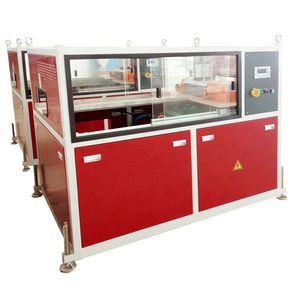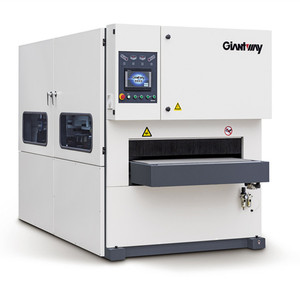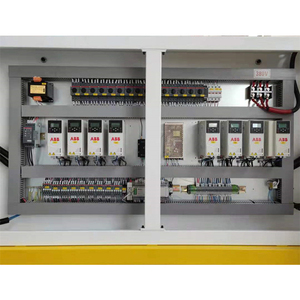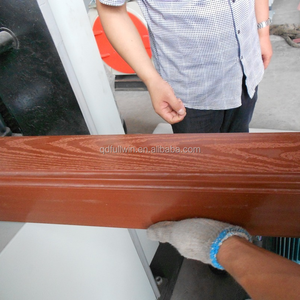Types of WPC Product Sanding Machines
The WPC product sanding machine highlights polishing as the final step in achieving a perfect finish. The sanding process can dull edges and gives the product a glossier look. The WPC sander works to give the product a softer and smoother feel and enhance the natural beauty of wood and other materials. There are three main types of WPC sanding machines: wide-belt sanders, edge, and detail sanders, as well as a sanding machine for wood known as the drum sander.
- Wide-belt sander:This powerful machine contains an electric motor that drives a wide sanding belt. It works by applying pressure from a rubber-covered drum to the moving sanding belt. The pressure-controlled drum, which is also known as a ride drum, exerts just enough pressure on the belt to sand products and also helps to support them. Broad belts can be used for products of nearly any width and can quickly accomplish many of the tasks.
- Edge and detail sander: This type of sander is usually the handheld machine that allows operators to reach indentations and crevices in a product. Since it is often held with two hands, it is easier to maneuver when sanding intricate details and contours in WPC products where large machines may be unable to reach. Personal safety is an utmost priority, so look for edge and detail sanders that come with guards and dust collection.
- Drum sander:The drum sander is known as the WPC sanding machine that is used for entire surface areas. It consists of a large cylinder that is covered in sandpaper and is driven by either a manual or automated feeding system. Unlike the wide belt sander that may just sand a portion of the item's surface, the drum sander can sand the entire surface all at once.
Specifications and Maintenance of WPC Product Sanding Machines
Specifications may vary by machine type and manufacturer. Key features include that WPC sander machines can be combined with a given number of sanding rolls or belts, their sizes, speed, and the level of automation.
- Combination of sanding rolls and belts: usually, the sanding rolls are combined with two to four sanding belts. The rolls are often used for the grinding of product cores, and the belts are employed for edge and surface grinding.
- Core material: the machine's core material will have an impact on product grinding quality and durability. Common core materials include wood, plastic, and others, each with its own characteristics and applications.
- Gamma: WPC product sanding machines usually have a certain grinding gamma to adapt to different product grinding needs. For example, some machines may have an open gamma that can process more diverse materials, while others may have a closed gamma for specific materials.
- Speed: the speed of a WPC product sander machine is usually adjustable to meet different product sanding needs. Generally, the higher the speed, the more efficient the grinding, but faster also may cause a rougher finish.
- Power: WPC product sanding machines' power ratings may vary according to their type and size. Generally, the higher the power, the stronger the machine's ability to grind.
- Operating system: some WPC product sanding machines are equipped with a computer-controlled system, allowing operators to set and control various parameters through a computer to achieve more precise and automated grinding operations.
Maintenance methods include the following:
- Regular cleaning: Cleaning the machine's surface, grinding belt or roller, and other parts to keep them clean and free from dust and debris. This will help prevent clogging and ensure a consistent sanding effect.
- Check the belt/roller: Periodically examine the condition of the sanding belts and rollers for signs of wear or damage. If they are worn out or damaged, they should be replaced or repaired in time.
- Lubricate moving parts: Apply an appropriate lubricant to the movable parts, such as bearings, sprockets, etc., to maintain smooth operation and reduce frictional wear.
- Adjust the sanding thickness: Regularly check and adjust the sanding thickness to ensure it meets the required specifications. Also, pay attention to the consistency of the sanding thickness to avoid mass audio defects.
- Dust removal and ventilation: Ensure the dust removal system is functioning correctly, and the ventilation holes are unobstructed to prevent excessive dust buildup and maintain a clean working environment.
- Replace filters: For sanding machines equipped with dust extraction systems, periodically replace or clean the filter to ensure effective dust extraction and air filtration.
- Inspection and maintenance of electrical systems: Periodically inspect the electrical system components, such as wiring, switches, etc., to ensure their connection is reliable and free from burnout or damage.
- Keep the machine bed level: Ensure that the machine base is level and firmly fixed to reduce vibrations and unstable operations during sanding.
- Development of a maintenance schedule: According to the manufacturer's instructions, establish a maintenance schedule and regularly perform inspections and repairs on the machine to ensure its good performance.
Scenarios of WPC product sanding machines
A WPC sanding machine for sale is applicable in various scenarios, especially in industries that work with wood products and other materials. Here are some common use scenarios for these machines:
-
Sanding Wood Products
A WPC sanding machine is designed to process and sand wood products. Such products may include planks, boards, and sheets. By using the machine, operators can uniformly sand the wood products to achieve a smooth surface. The smooth surface is crucial when it comes to improving final product presentation and enhancing paint or finish adherence.
-
Preparing for Finishing
Before applying oil, lacquer, paint, or any other type of finish, it is essential to prepare the wood product by sanding it first. Use the WPC sanding machine to carry out preliminary sanding before manually finishing the product with other sanding methods. The machine helps to achieve a consistent and even surface, which is crucial for a uniform and flawless final finish.
-
Sanding Composite Materials
Some advanced WPC sanding machines can handle and process composite materials (that are not just wood-based) other than plastics. Such materials include rubber, straw, and agricultural by-products. These machines are versatile and can easily be used to sand plastics, making them suitable for various industries such as construction, automotive, and marine.
-
Resizing and Shaping
Besides just sanding an end surface, WPC sanding machines can also be applied for reshaping and resizing wood products and planks. This is mostly the case when dealing with heavy-duty sanding machines with more robust motors. Such machines can efficiently change the dimensions of an existing wood product, including the length, breadth, and height.
-
Edge Finishing
A WPC machine can also come in handy during the process of edge finishing. Most wood products require edge finishing in order to achieve a smooth edge and prevent splintering. While machining edges can be done manually, it is a time-consuming process. Luckily, a WPC sanding machine can quickly and efficiently finish edges of doors, cabinets, and countertops, among other solid wood products.
-
Restoration Projects
In many routine home maintenance projects, an old, worn, and despite durable, still-functional wooden material need not be replaced but rather restored. Restoration projects can make many things good as new, including dining tables and wooden doors, to mention a few. The good thing is that with a sanding machine, the restoration becomes seamless. WPC sanding machines can be applied in restoration projects to sand and refinish antique furniture, hardwood floors, and wooden fixtures.
How to choose WPC product sanding machines
When purchasing a WPC sander, several factors need to be considered to ensure that the right machine is chosen for the specific application and production requirements. These factors include the type of WPC material, the surface finish requirement, production capacity, machine compatibility, control features, safety features, and budget and investment.
- Type of WPC material: It is essential to consider the type of WPC material to be processed by the sanding machine. Different types of WPC require different sanding techniques and equipment. For example, PVC-based WPC may need surface treatment to overcome the inherent slipperiness of the material, while other formulations may require different abrasives or sanders.
- Surface finish requirement: The desired surface finish (e.g., smooth, matte, glossy) will influence the choice of the sanding machine. Some machines are designed to achieve specific surface finishes, so it is essential to select one that can meet the production requirements.
- Production capacity: The production capacity of the sanding machine should match the overall processing needs of the production line. Consider factors such as the number of WPC products to be sanded daily, the size of the products, and the available workforce. If a large volume of products needs to be processed, a more significant capacity machine or one that allows for concurrent processing may be necessary.
- Machine compatibility: It is essential to consider that the sanding machine should be compatible with the other equipment in the production line. This includes checking product feeding systems, dust extraction units, and any automation or control interfaces that may be required for integration.
- Control features: The control functionalities offered by the sanding machine should be examined, including whether it is manually controlled or via a computer numerical control (CNC) system. More advanced CNC-controlled machines allow for greater flexibility and precision in sanding operations but may be more costly.
- Safety features: When selecting a WPC sanding machine, it is crucial to consider the occupational health and safety risks associated with the equipment. Poorly designed machines can expose users to a range of safety hazards, such as unguarded moving parts and electrical, fire, and operator health risks. It is essential to look for safety features such as emergency shut-off switches, safety guards, and dust collection systems to minimize the risk of accidents and ensure a safe working environment.
- Cost and warranty: Finally, it is essential to consider the cost of the sanding machine and any additional expenses, such as installation, training, and maintenance. Also, check the warranty period for the machine and the availability of customer support and service in case of any issues
wpc product sanding machine FAQ
Q1: Which type of sanding machine is widely used?
A1: The most used sanding machine in the world is the belt sander. It is widespread, especially in carpentry workshops and other joining industries. The reason the belt sander is so popular is because of its versatility.
Q2: What is the difference between sanding and surfacing?
A2: When a substance is polished, it is frequently made to shine or glow. As a result, polishing is not necessary to make a thing smooth. Sanding refers to the act of smoothing wood and other surfaces using sandpaper. While all polishing is sanding, not all sanding is polishing.
Q3: What is the largest type of sanding machine?
A3: The drum sander is the largest kind of sanding machine. Also, it is the largest power hand tool as far as dimensions are concerned. The sanding machine features a very large-sized drum, which is about 200mm in diameter.
Q4: Can a floor sander be used on woodwork?
A4: It isn't easy to recommend using a floor sander on woodwork. In theory, it is possible to use a floor sanding machine to sand wooden planks forming a structure like doors, window frames, and furniture. However, a large machine like the drum sander isn't suitable for precise work.


























































































































































































































